Black operations have been very busy as of late prepping the ground work for a long duration “hot war” centered on American proxy nations to engage China, while Russia is too preoccupied with NATO.
I have covered this in great detail over the last few years.
Here, in this article we will review the rewriting of history and how black operatives (out of the United States and the UK) are busy getting the world ready for a full onslaught engagement with China on proxy nation land. We will also include the anti-troll articles, the anti-shadow banning articles, and other techniques used to successfully throw-off the ‘bots that haunt the internet and search for targets.
This includes, food, cats, social issues, stories, and other issues.
We begin here…
Tiananmen lies and such
How psy-ops warriors fooled me about Tiananmen Square: a warning • Wenyahonline Journal.
An outstanding article.
1) NED In 1988, an office was set up in China by a relatively new organization with an innocent name – the National Endowment for Democracy. At that time, we reporters HAD NO IDEA it was a CIA spin-off, designed to build relationships with anti-government activists overseas for the purpose of spreading disinformation and destabilising communities in the interests of the US. 2) CIA In the following months, CIA agents helped Chinese student activists form an anti-government movement, and even provided typewriters, fax machines and other equipment to help them spread their message—this information came from a US official.
And it continues…
3) The Pentagon. A key player was Colonel Robert Helvey, a 30-year Pentagon veteran of destabilization operations in Asia. He “trained, in Hong Kong, the student leaders from Beijing in mass demonstration techniques, which they were to subsequently use in the Tiananmen Square incident of June 1989,” according to a highly detailed academic paper by B. Raman, the former director of India’s foreign intelligence agency.
4) A cry for more socialism. When protests broke out in China in April 1989, demonstrators were not calling for democracy, but purer socialism, free of corruption and inequality, which were endemic at the time. Students carried pictures of Chairman Mao and sang the Chinese national anthem repeatedly.
Western hybrid warfare includes two key principles:
a) Locate and amplify GENUINE local grievances, and
b) Rebrand them as calls for western liberal democracy and freedom.
5) Contact people rotated. The US State Department withdrew US ambassador Winston Lord, and replaced him with James Lilley, a veteran CIA agent who had run operations smuggling people in and out of China.
6) Rebranding. The Chinese protesters were advised by persons unknown to add the word “democracy” in English to their banners, and say they were calling for “freedom”, rather than their actual goal, a purer form of communism.
Such a great article. With loads of photos and quotes in the main article.
7) Image creation. The protesters were advised to create a statue and began work on May 27. But, as good communists, students chose to make it as unlike the Statue of Liberty as possible, basing their statue (replica on the right) on the work of Russian revolutionary communist sculptor Vera Mukhina (above). The students were not at all a homogenous group, but they were socialists. 8) American specialists called in. On May 28th, 1989, Gene Sharp, America’s top undercover street protest strategist, flew into Beijing with his assistant Bruce Jenkins to offer help. “The students in the square were operating with great commitment and bravery but they didn’t know what the hell they were doing,” Sharp later wrote. 9) Injection of hate. As May turned into June, the energy level dropped and there was need to bring things to a head. Student leader Chai Ling gave her infamous talk, where she warned of a massacre “which would spill blood like a river through Tiananmen Square”. She added that she expected to die shortly – but confusingly also said that she no longer intended to stay in China, but wanted to move to the United States. What did that mean? It was baffling at the time, but it would all make sense later. We now know that student leaders were promised [1] US passports, [2] CIA-run safe passage out of China, and [3] enrollment in top US universities. 10) China is patient. But there was a problem. Things were not coming to a head. The Chinese government was remaining remarkably restrained, as was the army. Because the main body of the protesters were asking for purer communism, people were politically on the same page – students and soldiers had good relationships, and even shared food and sang together. Violence finally started when a mysterious group of thugs, some from ethnic minorities, triggered a fight in Muxidi, five kilometers away, attacking army buses with petrol bombs and setting them alight, burning the occupants to death. This was unexpected, because gasoline was rationed and hard for ordinary people to obtain. Soldiers who managed to escape the burning buses were beaten to death. The word “massacre” could be used for this atrocity—although that doesn’t fit the western narrative, since it was soldiers who died. Other military men arrived in Muxidi and, infuriated at the sight of their slaughtered colleagues, shot at protesters (mostly unionists rather than students): there were many more tragic deaths, this time of civilians. 11) Things ended peacefully. Back in Tiananmen Square, in the early hours of June 4, soldiers arrived and called on students to leave. Student leader Feng Congde worked to gauge protesters opinions, and concluded that the majority wanted to leave. “So I announced the decision to leave,” he said. Students left peacefully. 12) A killing. At a different location on the periphery of the square, a fight broke out in which a soldier was killed, leading to some violence, according to a declassified report from the US Embassy. 13) More killings. One student protester, a friend of the present writer, watched one man lose his life. In the following skirmishes, several lives were lost. But in the square itself, the only gunfire came from bullets used to silence the sound system. 14) The lies begin. In contrast to this, a BBC reporter said he watched, from the Beijing Hotel, soldiers shooting at students in the center of the square. All eyewitness sources say this did not happen. It was also against the laws of physics – that location is not visible from the hotel. 15) The lies turn outrageous. Now this is where it gets strange. Over the following hours and days, a very different story was circulated, saying that the peaceful pro-democracy demonstrations in China had come to a violent and bloody end. A cable from the British Embassy said the students in the square had been massacred with machine guns, their bodies pushed into piles with bulldozers, and then incinerated by troops with flamethrowers. 16) More outrageous lies. A report was also sent out by the Australian Embassy delivering almost exactly the same information. “When all those who had not managed to get away were either dead or wounded, foot soldiers went through the square bayoneting or shooting anybody who was still alive,” said the report, read out loud by then Australian Prime Minister Bob Hawke. “They had orders that nobody in the square be spared, and children and young girls were slaughtered, anti-personnel carriers and tanks then ran backwards and forwards over the bodies of the slain until they were reduced to pulp, after which, bulldozers moved in to push the remains into piles which were then incinerated by troops with flamethrowers.” 17) The lies grow exponentially. An unknown (at the time) source was distributing related news “a minimum of 10,000 people had been massacred.” One document about this horrific (but fictional) massacre was sent to the Hong Kong office of the Wen Wei Po newspaper, from an anonymous source. In Beijing, a student, Wu’er Kaixi, said he could confirm that the story was true – he had watched it happen, he claimed. 18) Lies become super-funded. Then came an astonishing split. The main newsrooms of the international media chose to canonize the fictional “Tiananmen Square massacre” story as fact. We ran it at great length (and came to ritually repeat it every year since). But individual reporters at the scene, often working for the same media companies, took a very different line over the days, weeks, months and years that followed. 19) Truth is suppressed. The massacre story was quite wrong, said Jay Mathews, former Beijing bureau chief for the Washington Post. “A few people may have been killed by random shooting on streets near the square, but all verified eyewitness accounts say that the students who remained in the square when troops arrived were allowed to leave peacefully.” 20) The famous parrot the lies. New York Times reporter Nicholas Kristof, a bitter critic of China, wrote: “There is no massacre in Tiananmen Square, for example, although there is plenty of killing elsewhere.” 21) The truth comes out 30 years later. Some told the truth years later. In 2009, James Miles, a senior BBC correspondent in Beijing at the time, admitted that he had “conveyed the wrong impression” and that “there was no massacre on Tiananmen Square.” 22) More truths in small drips and dabs. Graham Earnshaw of Reuters, who was in the square, wrote a detailed report in his memoir explaining how the military came, negotiated with the students and made everyone, including himself, leave peacefully. 23) Debunking the narrative is well known. Even the student protesters debunked the story. Wu’er Kaixi, who claimed to have seen the massacre with his own eyes, wasn’t even there, they said. He had left the Square hours earlier. It was later revealed that Wu’er was a Xinjiang Uyghur named Örkesh Dölet. He was spirited out of China through the Hong Kong-based “Operation Yellowbird” and taken to the US, where he was given a place at Harvard University. More recently, Wu’er Kaixi/ Örkesh Dölet drew parallels between the Tiananmen Square massacre and the Hong Kong 2019 riots—perhaps more accurately than he realized, both being heavily misreported using the exact same techniques, by the exact same unholy alliance of behind the scenes manipulators and anti-Chinese journalists. 24) The true has been suppressed. Madrid’s ambassador to Eugenio Bregolat was filled with righteous anger. He noted that western journalists were reporting the massacre as fact from their hotel guestrooms, while Spain’s TVE channel had a television crew physically in the square that evening and knew it was false. 25) Diplomats knew. In fact, most diplomats knew the Tiananmen Square massacre story was fake. “Within a few days, certainly within a week, it was clear that the information about what happened in the square itself was incorrect,” Professor Richard Rigby, a staff member at the Australian Embassy in 1989, told reporters on an ABC news show. 26) The US completely knew. US Embassy officials interviewed a Chilean diplomat who had been present in the Square at the time of the alleged massacre. He confirmed that no such thing happened. The officials kept the information secret – until it was exposed by Julian Assange’s Wikileaks operation in 2011. 27) Black Operations. Many diplomats strongly suspected that the Tiananmen Square fiction was “a black op”. Australia’s Professor Rigby later said: “I cannot entirely rule out the possibility that we were being fed some sort of a ‘line’.” 28) USA and UK involvement. That, of course, was exactly what had happened. “The mystery report was very likely the work of the US and UK black information authorities ever keen to plant anti-Beijing stories in unsuspecting or cooperative media,” said Gregory Clark, a British-born Australian diplomat. 29) History has been changed. A pair of human rights campaigners, again, harsh critics of the Chinese government, were also uncompromising. In a book, George Black and Robin Munro wrote: “The phrase ‘Tiananmen Square massacre’ is now fixed firmly in the political vocabulary of the late twentieth century. Yet it is inaccurate. There was no massacre in Tiananmen Square on the night of June 3.” 30) Mainstream media. Still, almost all the mainstream media clung tightly to their fiction. On air, Tim Russert of NBC’s Meet the Press recalled the machine gun deaths of “ten thousand students”. 31) Nothing to report. A group called the June Fourth victims’ network decided to gather the names of the ten thousand dead for publication by a New York group called Human Rights in China. After ten years of research, the list of victims was just 155 names long, one source said. The story seems to have disappeared. 32) All debunked. In 2017, diplomatic papers quietly declassified by the British government showed that it was British Ambassador Sir Alan Donald in Beijing who had spread the debunked news that that a minimum of 10,000 citizens died. The BBC and other media continues to present this as if was a credible fact from a credible source, rather than a piece of discredited fiction almost certainly from a “black op”. The BBC newsroom gives credence to the story of 10,000 deaths in the square, even though it has been has been widely debunked, including by its own staff 33) The lies live on. Western publishers of many types continue to present the massacre story as fact. The Lonely Planet series, one of the world’s best-selling travel books, includes this line in its volume on China: “Eyewitness accounts have indicated that hundreds died in the square alone, and it’s likely fighting in the streets around the square led to another several thousand casualties.” 34) The lies get worse and worse with time. The “Encyclopedia of the World” (Houghton Mifflin Co, 2001) tells the children of the world, in shocked capital letters, a version of the tale even more extreme that the black op version: “June 3-4: PLA TROOPS ENTERED TIANANMEN SQUARE DURING THE NIGHT AND FIRED DIRECTLY INTO THE SLEEPING CROWD.” 35) What to do? It appears there’s nothing that can be done. Western media simply swallows disinformation about mainland China or Hong Kong and spits it out as fact, and continues to do so on a daily basis. Gregory Clark notes the incalculable harm to humanity done by “CIA/MI6 black information massacre myths and Western media gullibility”. They have prevented, and continue to prevent, any sort of accurate understanding of the recent history of the most populous community on earth. “A major lesson from all this is the need to control our Western black information operations. Few seem to realize the depth of their penetration in Western media,” he wrote. GHOSTS IN THE MACHINE Now there are going to be some people who will not accept that the story we so long believed, that peaceful pro-democracy demonstrations in China came to a violent and bloody end, was a “psy-ops” operation by US disinformation specialists. To those people, I would point to a recruitment video by US military disinformation specialists released this year. It aims to introduce viewers to the world of international disinformation techniques. Called Ghosts in the Machine, it begins with black and white cartoonish images and words, and then we hear a newscaster speaking the following sentence: “As the world watches and listens in horror, the peaceful pro-democracy demonstrations in China come to a violent and bloody end.”
A kitty rescue
Let’s begin on a positive note with this video about rescuing this beautiful feral kitten.
New Reuters Survey Finds That Trust In Mainstream News Is Rapidly Declining
It probably does not come as much of a surprise to most people today, but it is now confirmed by the mainstream media’s own surveys – They are rapidly losing their audience and their influence.
The Reuters Institute For The Study Of Journalism runs a yearly project designed to gauge public perceptions of media, specifically corporate media, and how much trust the MSM has garnered. Spoiler Alert: They haven’t garnered any. In fact, over the course of the past two years establishment journalists have alienated a large portion of the general public.
The latest survey finds that globally, 38% of people are avoiding most news altogether, indicating that coverage of specific subjects such as covid had become ‘repetitive’ and depressing. This is an increase of almost 10% from 2017. The more vital statistic, though, is the number of people that do not trust the media at all.
Globally, only 42% of people said they trust the media most of the time. In the US, only 26% said they trust the media, a three point dip from 2021. This is reinforced by the exponential decline in mainstream news ratings in the past few years.
CNN lost approximately 70% of its audience in key demographics this year, and the network recently suffered one of the smallest weekly audience ratings since 2015. The collapse of the CNN+ paid membership program before it ever got off the ground also indicates a complete lack of public interest in the extreme leftist ideology pumped out by the network.
MSNBC’s audience numbers were also down 32% this month as their prime time shows struggle to maintain a viewership of 1 million people. Even the Jan 6th hearings, touted as a historic event for the US that would supposedly present “proof” of a planned “insurrection” of the federal government, only pulled in 20 million viewers across 12 networks; that’s around 6% of the American population that bothered to watch. Fox New is the only corporate network that appears to be holding a steady audience.
Is it any wonder that the establishment media has been working so closely with social media platforms like Facebook and YouTube to artificially push their content into top search results? With the population thoroughly disgusted with the media’s constantly biased coverage of the pandemic event, the BLM riots, the Hunter Biden Laptop issue, the Ukraine war as well as the ongoing economic crisis, the only way the MSM can get people to watch them is when they work with Big Tech to force people to watch them.
It’s simple, when you constantly lie to the public eventually they will ignore you.
SWIFT dollar decline
SYDNEY and KUALA LUMPUR: U.S.-led sanctions are inadvertently undermining the dollar’s post-Second World War dominance. The growing number of countries threatened by U.S. and allied actions is forcing victims and potential targets to respond pro-actively.
SWIFT strengthened dollar
The instant messaging system of the Society for Worldwide Interbank Financial Telecommunication (SWIFT) informs users, both payers and payees, of payments made. Thus, it enables the smooth and rapid transfer of funds across borders.
Created in 1973, and launched in 1977, SWIFT is headquartered in Belgium. It links 11,000 banks and financial institutions (BFIs) in more than 200 countries. The system sends over 40 million messages daily, as trillions of U.S. dollars (USD) change hands worldwide.
Co-owned by more than 2,000 BFIs, it is run by the National Bank of Belgium, together with the G-10 central banks of Canada, France, Germany, Italy, Japan, the Netherlands, Sweden, Switzerland, the UK and the U.S.. Joint ownership was supposed to avoid involvement in geopolitical disputes.
Many parties use USD accounts to settle dollar-denominated transactions. Otherwise, banks of importing and exporting countries would need accounts in each other’s currencies in their respective countries in order to settle payments.
SWIFT abuse
U.S. and allied–including European Union (EU)–sanctions against Russia and Belarus followed their illegal invasion of Ukraine. Created during the U.S.-Soviet Cold War, SWIFT remains firmly under Western control. It is now used to block payments for Russian energy and agriculture exports
But besides stopping income flows, it inadvertently erodes USD dominance. As sanctions are increasingly imposed, such actions intimidate others as well. While intimidation may work, it also prompts other actions.
This includes preparing for contingencies, e.g., by joining other payments arrangements. Such alternatives may ensure not only smoother, but also more secure cross-border financial transfers.
As part of U.S.-led sanctions against the Islamic Republic, the EU stopped SWIFT services to Iranian banks from 2012. This blocked foreign funds transfers to Iran until a compromise was struck in 2016.
U.S. financial hegemony
Based in Brussels, with a data centre in the U.S., SWIFT is a ‘financial panopticon’ for surveillance of cross-border financial flows. About 95% of world USD payments are settled through the private New York-based Clearing House Interbank Payments System (CHIPS), involving 43 financial institutions.
About 40% of worldwide cross-border payments are in USD. CHIPS settles U.S.$1.8 trillion in claims daily. As all CHIPS members maintain U.S. offices, they are subject to U.S. law regardless of headquarters location or ownership.
Hence, over nearly two decades, CHIPS members like BNP Paribas, Standard Chartered and others have paid nearly U.S.$13 billion in fines for Iran-related sanctions violations under U.S. law!
Exorbitant privilege
The USD remains the currency of choice for international trade and foreign reserve holdings. Hence, the U.S. has enjoyed an “exorbitant privilege” since World War Two after the 1944 Bretton Woods conference created the gold-based ‘dollar standard’–set at U.S.$35 for an ounce of gold.
With the USD remaining the international currency of choice, the U.S. Treasury could pay low interest rates for bonds that other countries hold as reserves. It thus borrows cheaply to finance deficits and debt. Hence, it is able to spend more, e.g., on its military, while collecting less taxes.
Due to USD popularity, the U.S. also profits from seigniorage, namely, the difference between the cost of printing dollar notes and their face value, i.e., the price one pays to obtain them.
In August 1971, President Nixon unilaterally ‘ended’ U.S. obligations under the Bretton Woods international monetary system, e.g., to redeem gold for USD, as agreed. Soon, the fixed USD exchange rates of the old order–determining other currencies’ relative values–became flexible in the new ‘non-system’.
In the ensuing uncertainty, the U.S. ‘persuaded’ Saudi King Feisal to ensure all oil and gas transactions are settled in USD. Thus, OPEC’s 1974 ‘petrodollar’ deal strengthened the USD following the uncertainties after the Nixon shock.
Nevertheless, countries began diversifying their reserve portfolios, especially after the euro’s launch in 1999. Thus, the USD share of foreign currency reserves worldwide declined from 71% in 1999 to 59% in 2021.
With U.S. rhetoric more belligerent, dollar apprehension has been spreading. On 20 April 2022, Israel–a staunch U.S. ally–decided to diversify its reserves, replacing part of its USD share with other major trading partners’ currencies, including China’s renminbi.
Sanction reaction
The EU decision to bar Iranian banks from SWIFT prompted China to develop its Cross-border Interbank Payment System (CIPS). Operational since 2015, CIPS is administered by China’s central bank. By 2021, CIPS had 80 financial institutions as members, including 23 Russian banks.
At the end of 2021, Russia held nearly a third of world renminbi reserves. Some view the recent Russian sanctions as a turning point, as those not entrenched in the U.S. camp now have more reason to consider using other currencies instead.
After all, before seizing about U.S.$300 billion in Russian assets, the U.S. had confiscated about U.S.$9.5 billion in Afghan reserves and U.S.$342 million of Venezuelan assets.
Threatened with exclusion from SWIFT following the 2014 Crimea crisis, Russia developed its own SPFS (Financial Message Transfer System) messaging system. Launched in 2017, SPFS uses technology similar to SWIFT’s and CIPS’s.
Both CIPS and SPFS are still developing, largely serving domestic BFIs. By April 2022, most Russian banks and 52 foreign institutions from 12 countries had access to SPFS. Ongoing developments may accelerate their progress or merger.
The National Payments Corporation of India (NPCI) has its own domestic payments systems, RuPay. It clears millions of daily transactions among domestic BFIs, and can be used for cross-border transactions.
Sanctions cut both ways
Unsurprisingly, those not allied to the U.S. want to change the system. Following the 2008-9 global financial crisis, China’s central bank head called for “an international reserve currency that is disconnected from individual nations”.
Meanwhile, China’s USD assets have declined from 79% in 2005 to 58% in 2014, presumably falling further since then. More recently, China’s central bank has been progressively expanding use of its digital yuan or renminbi, e-CNY.
With over 260 million users, its app is now ‘technically ready’ for cross-border use as no Western bank is needed to move funds across borders. Such payments for imports from China using e-CNY will bypass SWIFT, and CHIPS will not need to clear them.
Russia has long complained of U.S. abuse of dollar hegemony. Moscow has tried to ‘de-dollarize’ by avoiding USD use in trade with other BRICS–i.e., Brazil, India, China and South Africa–and in its National Wealth Fund holdings.
Last year, Vladimir Putin warned the U.S. is biting the hand feeding it, by undermining confidence in the U.S.-centric system. He warned, “the U.S. makes a huge mistake in using dollar as the sanction instrument”.
The scope of U.S. financial payments surveillance and USD payments will decline, although not immediately. Thus, Western sanctions have unwittingly accelerated erosion of U.S. financial hegemony.
Besides worsening stagflationary trends, such actions have prompted its targets–current and prospective–to take pre-emptive, defensive measures, with yet unknown consequences.
Here’s The Best Combined Explanation For Surging Inflation: Cascading Idiocy
Authored by Mike Shedlock via MishTalk.com,
Cascading Policy Errors
1: Covid hit. Lockdowns that were arguably excusable in the beginning, lingered far too long, affecting far too many businesses. Policy error one.
2: The Fed reacted with QE far to excessive and far too long, continuing all the way until March 2022. Policy error two.
3. Free Money from Congress. Again excusable in the beginning, but the second round by Trump was excessive and the third by Biden was preposterous. Policy errors three and four with Biden getting far more of the blame.
4. Demand shift to goods away from services as a result of the above three items.
5. The demand shift to goods happened when there were fewer workers due to continuing lockdowns.
6. The US meddled in Ukraine in 2014 setting the stage for war. And Ukrainian President Volodymyr Zelenskyy kept insisting to the bitter end it wanted to be in the EU and NATO, both red flags to Putin. Accurately label Zelenskyy’s statements a policy error. And blame Putin for the war, so that makes policy errors five, six, and seven counting US meddling in 2014.
7: Let’s not leave Angela Merkel out of this. Kowtowing to the Greens, Merkel mothballed Germany’s nuclear plants creating greater dependence on energy from Russia. This is policy error number eight.
8. And what about Biden and the US Greens telling Big Oil it wanted to put them out of business. Guess what? Energy investment plunged. Policy error number 9.
9. Inane sanctions in response to the war busted supply chains in energy. Policy errors ten and eleven by the US and EU.
10. Finally, please consider Biden’s stupid energy policy to rising oil price. Instead of taking actions to increase oil supply, Biden blamed oil companies, threated tax hikes, threated FTC involvement, blamed gouging, then with refinery capacity already crippled demanded more ethanol from corn. The ethanol demand will increase need for fertilizer, increase summer smog, and drive more small refiners out of business.
I am not sure how many policy errors there are in point ten. Pick a number.
Passing the Buck
Putin Tax
Search for Enemies
Paul Krugman, No Policy Errors?!
No, it’s not all Biden’s fault. It’s Biden, the Fed, Congress, Merkel, Putin, Trump, the EU, and Zelenskyy.
Please apportion the blame, but here’s a simple way to start:
-
- It’s mostly Progressive free money policies by Biden and Congress coupled with inane responses to to the war with the Fed providing excess stimulus all the way to March of 2022.
- Key policy errors by Merkel and the US in 2014 set the stage for compounding everything that followed.
Putin: “Previous World Order, Won’t Return”
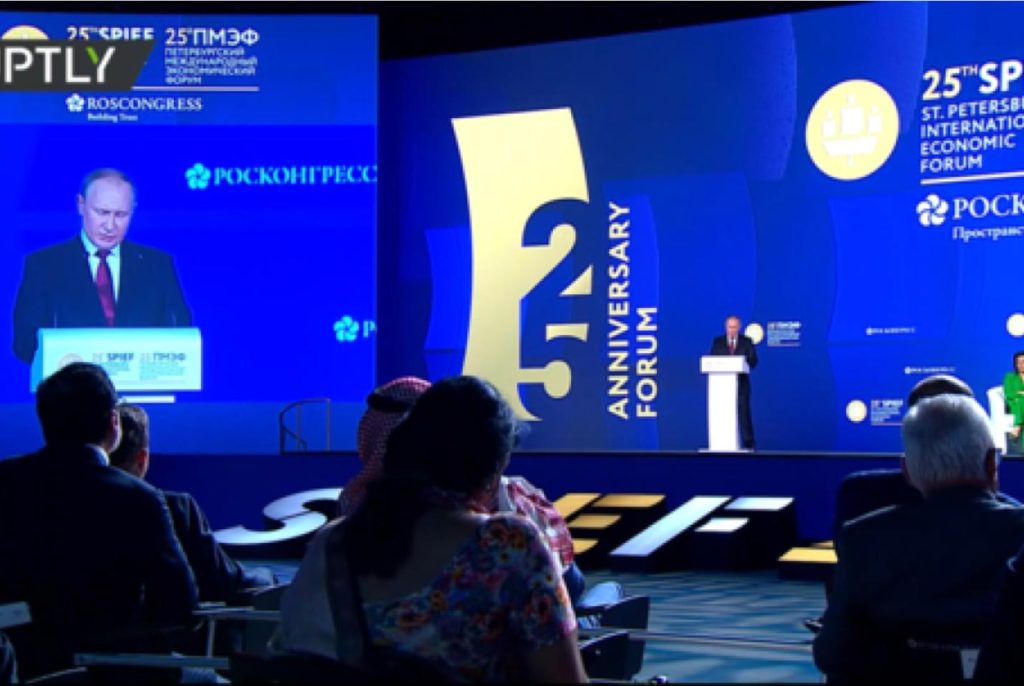
Those who believe that things will go back to the way they were before the outbreak of the conflict in Ukraine are wrong, Russian President Vladimir Putin has said.
“It is a mistake to suggest that the times of turbulent changes can be waited out and that things will return to normal; that everything will be as it was. It won’t,” Putin insisted during his speech at the the Saint Petersburg International Economic Forum (SPIEF) on Friday.
The changes that the world is going through at the moment are fundamental, radical, and irreversible, he added.
However, the ruling elites of some Western countries refuse to notice this obvious shift and choose to “cling to the shadows of the past,” he added.
For example, they believe that the dominance of the West in global politics and economy is a constant, eternal value,” Putin said. But “nothing is eternal,” he reminded everyone.
Since claiming victory in the Cold War in the early 1990s, the US has “declared itself the messenger of God on Earth, who has no obligations, but only interests, and those interests are pronounced to be sacred,” the president said.
However, the idea of a unipolar world is flawed at its core, according to the Russian leader, as the norms of international relations can’t always be interpreted in favor of a single nation, “even if it’s a strong one.”
It seems as if Washington refuses to see the new centers of power that have emerged in recent decades and which have every right to “protect their interests and ensure their national sovereignty,” he said.
Putin’s June 2022 Speech
I’m slowly moving through Putin’s speech pulling out gems to further illuminate and discuss them. Here’s yet another where he provides an interesting description of Neoliberalism:
"Of course, perhaps we would be pleased to hear that we are so powerful and omnipotent: inflation is blown to the skies in the West, in the United States, in Europe, and we are doing something else that makes everyone nervous. Maybe it would be nice for us to feel such power, but this is not true. The situation has matured for years, spurred on by the short-sighted actions of those who are accustomed to solving their problems at someone else's expense, who relied and still rely on the mechanism of financial emission to buy, pull on trade flows and thereby exacerbate deficits and provoke humanitarian disasters in certain regions of the world. I would like to add that this is essentially the same predatory and colonial policy, but, of course, in a new form, in a new edition, it is much more subtle and sophisticated. You won't know what's going on right away."
Yes, it’s been well hidden for decades; and in reality, for well over a century–since the 1880s. IMO, there’s only one method of slaying it: Proper education that leads to political then policy change. There’s hope that as usual economic pain will help remove the political blinders that keep the masses enslaved.
Peach Crisp
When you’re craving a taste of summer, reach for this beyond-easy recipe. All it takes is 10 minutes of prep, a few basic ingredients and your choice of fresh, frozen, or canned peaches to make this sweet fruit crisp. Oatmeal cookie mix creates the perfect texture and adds just the right amount of nuttiness, balancing out the juiciness from the peaches and richness from the butter. We recommend serving this dish warm with a hearty scoop of vanilla ice cream or even a drizzle of caramel for a perfectly peachy dessert!




MoA has something interesting to say…
Today, without any announcement, the British prime minister Boris Johnson, undoubtedly on order of Biden, appeared in Kiev to lobby for more war just like he did at the end of March when he told Ukraine’s president Zelensky to ditch the negotiations with Russia.
That is why I fear that Michael Brenner is right and that Biden will escalate the war by attacking somewhere else:
Necessity is the mother of invention — or so it is said. However, grasping what is “necessary” can be a very slippery business. An actual recasting of how one views a problematic situation normally is a last resort. Experience and history tell us that, as do behavioral experiments. ... So, you are stuck with the albatross of a truncated, bankrupt Ukraine hung around your neck. There is nothing that you can do to cancel these givens — except a direct, perhaps suicidal test of force with Russia. Or, perhaps, a retaliatory challenge elsewhere. The latter is not readily available — for geographic reasons and because the West already has expended its arsenal of economic and political weaponry. Over the past year, the U.S. attempted to foment Maiden style regime changes in Belarus and Kazakhstan. Both were foiled. The latter was with the connivance of Turkey, which deployed a contingent of bashi bazouks from the stock of Syrian jihadis it keeps on call in Idlib (to be deployed as President Recep Erdogan did more successfully in Libya and Azerbaijan). There remains one conceivable sensitive target: Syria. There, the Israelis have become increasingly audacious in goading the Russians by airstrikes against Syrian infrastructure as well as military facilities. Now, we see signs that Moscow’s tolerance is wearing thin, suggesting that further provocations could spark retaliation which Washington then could exploit to ratchet up tensions. To what avail? Not obvious — unless the ultras in the Biden administration are looking for the kind of direct confrontation that they’ve avoided in Ukraine, until now. The implication is that the denial option and the incremental adjustment option are foreclosed. Serious rethinking is in order — logically speaking. The most worrisome scenario sees the frustration and anger and anxiety building in Washington to the point where it encourages a reckless impulse to demonstrate American prowess. That could take the form of an attack on Iran in the company of Israel and Saudi Arabia — the region’s new odd couple. Another, even grimmer prospect would be a contrived test of wills with China. Already we see growing evidence of that in the bellicose rhetoric of American leaders from U.S. President Joe Biden on down.
The Pentagon is not ready for a war on China. Iran is too strong and would respond to an attack by launching its huge missile arsenal on Israel and U.S. allies in the Gulf. This leaves Syria. It is unlikely by chance that the Wall Street Journal reported yesterday that the U.S. is coordinating Israeli airstrikes in that country:
WASHINGTON—Israel secretly coordinates with the U.S. on many of the airstrikes it carries out in Syria as the allies face a battlefield crowded with militant groups, Iranian-backed militias and foreign militaries, according to current and former U.S. officials.
I expect those airstrikes, like last week’s attack on the airport of Damascus, to intensify with the hope to divert Russian attention from Ukraine.
Russia is of course 100% prepared for that but U.S. miscalculations that led to this are many and I do not expect that tendency to change anytime soon.
In his latest talk about The causes and consequences of the Ukraine war (vid) John Mearsheimer also speaks of why he thinks that an escalation is likely, and what the potential results might be. Without the Q&A it is only one hour long and well worth your time.
Posted by b on June 17, 2022 at 16:35 UTC | Permalink
FRANCE CUT-OFF COMPLETELY FROM RUSSIAN NATURAL GAS
All flows of natural gas from Russia to France have suddenly HALTED via the Nord Stream Pipeline.
France gets around 17 percent of its gas from Russia through network connections with Germany, which relies heavily on Russian supplies and has criticized Gazprom’s move as “political.”
Gazprom said the supply reductions via the Nord Stream pipeline are the result of repair work, but EU officials believe Moscow is punishing allies of Ukraine, where Russian forces launched an invasion in February.
Our American Economy In A Nutshell
Authored by Charles Hugh Smith via OfTwoMinds blog,
The economy has reached an inflection point where everything that is unsustainable finally starts unraveling.
Our economy is in a crisis that’s been brewing for decades. The Chinese characters for the English word crisis are famously–and incorrectly–translated as danger and opportunity. The more accurate translation is precarious plus critical juncture or inflection point.
Beneath its surface stability, our economy is precarious because the foundation of the global economy– cheap energy–has reached an inflection point: from now on, energy will become more expensive.
The cost will be too low for energy producers to make enough money to invest in future energy production, and too high for consumers to have enough money left after paying for the essentials of energy, food, shelter, etc., to spend freely.
For the hundred years that resources were cheap and abundant, we could waste everything and call it growth: when an appliance went to the landfill because it was designed to fail (planned obsolescence) so a new one would have to be purchased, that waste was called growth because the Gross Domestic Product (GDP) went up when the replacement was purchased.
A million vehicles idling in a traffic jam was also called growth because more gasoline was consumed, even though the gasoline was wasted.
This is why the global economy is a “waste is growth” Landfill Economy. The faster something ends up in the landfill, the higher the growth.
Now that we’ve consumed all the easy-to-get resources, all that’s left is hard to get and expensive. For example, minerals buried in mountains hundreds of miles from paved roads and harbors require enormous investments in infrastructure just to reach the deposits, extract, process and ship them to distant mills and refineries. Oil deposits that are deep beneath the ocean floor are not cheap to get.
Does it really make sense to expect that the human population can triple and our consumption of energy increase ten-fold and there will always be enough resources to keep supplies abundant and prices low? No, it doesn’t.
Many people believe that nuclear power (fusion, thorium reactors, mini-reactors, etc.) will provide cheap, safe electricity that will replace hydrocarbons (oil and natural gas). But nuclear power is inherently costly, and there are presently no full-scale fusion or thorium reactors providing cheap electricity to thousands of households.
Reactors take many years to construct and are costly to build and maintain. Cost over-runs are common. A new reactor in Finland, for example, is nine years behind schedule and costs have tripled.
The U.S. has built only two new reactors in the past 25 years.
The world’s 440 reactors supply about 10% of global electricity. There are currently 55 new reactors under construction in 19 countries, but it will take many years before they produce electricity. We would have to build a new reactor a week for many years to replace hydrocarbon-generated electricity. This scale of construction simply isn’t practical.
Supplying all energy consumption globally–for all transportation, heating of buildings, etc.) would require over 10,000 reactors by some estimates–over 20 times the current number of reactors in service.
Many believe so-called renewable energy such as solar and wind will replace hydrocarbons. But as analysts Nate Hagens has explained, these sources are not truly renewable, they are replaceable; all solar panels and wind turbines must be replaced at great expense every 20 to 25 years. These sources are less than 5% of all energy we consume, and it will take many decades of expansion to replace even half of the hydrocarbon fuels we currently consume.
To double the energy generated by wind/solar in 25 years, we’ll need to build three for each one in service today: one to replace the existing one and two more to double the energy being produced.
All these replacements for hydrocarbons require vast amounts of resources: diesel fuel for transport, materials for fabricating turbines, panels, concrete foundations, and so on.
Humans are wired to want to believe that whatever we have now will still be ours in the future. We don’t like being told we’ll have less of anything in the future.
The current solution is to create more money out of thin air in the belief that if we create more money, then more oil, copper, iron, etc. will be found and extracted.
But this isn’t really a solution. What happens if we add a zero to all our currency? If we add a zero to a $10 bill so it becomes $100, do we suddenly get ten times more food, gasoline, etc. with the new bill? No.
Prices quickly rise ten-fold so the new $100 bill buys the same amount as the old $10.
Adding zeroes to our money (hyper-financialization) doesn’t make everything that’s scarce, expensive and hard to get suddenly cheap. It’s still scarce, expensive and hard to get no matter how many zeroes we add to our money.
Many people feel good about recycling a small part of what we consume. But recycling is not cost-free, and the majority of what we consume is not recycled.
The percentage of lithium batteries that are recycled, for example, is very low, less than 5%. We have to mine vast quantities of lithium because we dump 95% of lithium-ion batteries in the landfill. There are many reasons for this, one being that the batteries aren’t designed to be recycled because this would cost more money.
The majority of all manufactured goods–goods that required immense amounts of hydrocarbons to make–are tossed in the landfill.
Goods and services are commoditized and sourced from all over the world in long dependency chains (hyper-globalization): if one link breaks, the entire supply chain breaks.
Our economy is precarious because it’s in a lose-lose dilemma: resource prices can’t stay high enough for producers to make a profit without impoverishing consumers. Prices can’t stay low enough to allow consumers to spend freely without producers losing money and shutting down, depriving the economy of essential resources.
Playing hyper-financialized games–creating money out of thin air, borrowing from tomorrow to spend more today and inflating speculative bubbles in stocks, housing, etc.–won’t actually create more of what’s scarce. All these games make wealth inequality worse (hyper-inequality), undermining social stability.
The economy has reached an inflection point where everything that is unsustainable finally starts unraveling. Each of these systems is dependent on all the other systems (what we call a tightly bound system), so when one critical system unravels, the crisis quickly spreads to the entire economic system: one domino falling knocks down all the dominoes snaking through the global economy.
Those who understand how tightly interconnected, unsustainable systems are basically designed to unravel can prepare themselves by becoming antifragile: flexible, adaptable and open to the opportunities that arise when things are disorderly and unpredictable.
20,000 Women and 100,000 Castrated Men to Serve the Emperor: The Imperial Harem of China
In Imperial China, one of the important tasks that the emperor needed to do was to ensure the continuation of the dynasty, which was achieved by the production of a male heir. For this purpose, the emperors of Imperial China kept an enormous harem of women. There was a hierarchy in the emperor’s harem, and whilst the exact classes changed over the millennia, it may be said that in general there were three ranks – the empress, consorts, and concubines. In addition, the eunuchs who served these imperial women may be considered to be a part of this harem as well.
Hierarchy in the Harem
At the top of the hierarchy of the Imperial Chinese harem was the empress, who was the Emperor’s one ‘official wife’. The empress was the most venerated and revered figurehead for women in China, as she was considered to be the ‘mother of the world’. In the harem, only the emperor and the mother of the emperor were above the empress, all other individuals had to obey her orders. In addition to empresses, there was also the rank of empress dowager. Empresses who outlived their husbands were promoted to this rank. Some famous empress dowagers include Wu Zetian of the Tang Dynasty (who later became China’s first female emperor) and Cixi of the Qing Dynasty.
Consorts in the Imperial Chinese Harem
Underneath the empress were the consorts. The number and ranks of these consorts differed according to the ruling dynasty. During the Qing Dynasty, for example, an imperial harem would have had one Imperial Noble Consort, two Noble Consorts, and four Consorts. Below these consorts were the concubines, and this number varied according to each emperor. According to the Rites of Zhou , an emperor could have up to 9 high ranking concubines, 27 mid ranking ones and 81 low ranking ones. However, during the Han Dynasty (206 BC – 220 AD), there were no limits set for the number of consorts an Emperor could have, and during the reigns of Emperor Huan and Emperor Ling, there were more than 20,000 women living in the Forbidden City.
Selection of Concubines
During the Ming Dynasty (1368-1644 AD), there was an official system for selecting concubines to join the emperor’s harem. The selection process would take place inside the Forbidden City every three years. Candidates ranged from 14 to 16 years of age and were chosen based on their background, virtues, behavior, character, appearance and body condition.
Eunuchs – The Only Males Allowed in the Harem
To ensure that any child born in the harem was fathered by the emperor, males were not allowed to serve the women of the emperor’s harem.
The only exceptions to this rule were the eunuchs, men who had been castrated, thus rendering them impotent. Throughout the history of Imperial China, eunuchs have served the imperial family, including as servants in the harem. Far from being mere servants, however, these eunuchs could aspire to positions of power and wealth by involving themselves in the politics of the harem. During the Ming Dynasty (1368–1644), there was an eye-opening 100,000 eunuchs serving the emperor and his harem.
Rivalries in the Harem
With so many women in the harem, it was inevitable that rivalries amongst the emperor’s women would arise, as they competed for the emperor’s attention. The most coveted position was, of course, that of the empress, and to bear a son for the emperor would certainly be a big bonus to a woman in the harem. At times, ambitious women in the harem who plotted against their rivals would form alliances with eunuchs. If an intrigue was successful, a woman in the harem could rise through the ranks. She, in turn, would reward the eunuchs who supported her by placing them in positions of authority.
Such harem intrigues have happened often in Chinese history. For example, during the Tang Dynasty, one of the Emperor Gaozong’s consorts was Wu Zetian. According to popular belief, Wu Zetian had her new born child murdered, and placed the blame on the Empress Wang. As a result of this, the empress was demoted, and Wu Zetian became the new empress. Nevertheless, not all imperial harems were hotbeds of conspiracy. The semi-mythical Huangdi, for example, had four concubines, who were not chosen based on their looks, but on their competence. One of his secondary concubines, for instance, is regarded as the inventor of cooking and of the chopsticks, whilst another is believed to have invented the comb. Together, these concubines assisted Huangdi in ruling the country.
Many concubines met a sad fate when their emperor died. They were sacrificed, often buried alive, to join their master in the afterlife.
Dan Bongino: The Biden administration is slowly dying
A decent enough FOX video.
“Red Flag” laws as a way to abolish Habius Corpus
Yeah. I know. “Democrats are gonna get and ban guns”. Well, right now, it’s the uni-party; both Republicans and Democrats that want to do this.
What this means, of course is that the USA is RIPE for a civil war. Look at the ingredients…
- Ballistic inflation.
- Banning gun ownership.
- Disastrous international policies
- Out of touch leadership
"Let them drive electric cars!"
- No domestic spending.
- Insane levels of foreign spending.
- Threat of nuclear war with Russia and China simultaneously.
Third American captured in Ukraine fighting with the Nazis.
A third former U.S. serviceman who has gone missing in Ukraine has been identified, but his whereabouts remain unknown.
Family and friends of Grady Kurpasi, who served in the Marine Corps for 20 years, last heard from the veteran on April 24, according to a report. Kurpasi arrived in Ukraine to volunteer alongside Ukrainian forces on March 7. His last known location was in the Kherson region, in southeastern Ukraine, where he manned an observation post in late April. Kherson is occupied by Russian forces.
“For him personally, he has a skill set that he feels he can give back,” George Heath, a family friend of Kurpasi’s, told CNN on Thursday. “He wanted to go and help the Ukrainian people. He wasn’t really planning on fighting.”
State Department spokesman Ned Price said on Thursday that the department is aware of the third missing American in Ukraine and is “in touch with the family.”
On Wednesday, reports emerged that two other former U.S. servicemen had been captured by Russian forces in Ukraine.
A photo purportedly of the two volunteers, Alexander Drueke and Andy Huynh, was posted on the social media platform Telegram on Thursday by a Russian blogger. The image purported to show the two in the back of a Russian military truck with their hands apparently tied behind their backs.
“We are aware of unconfirmed reports of two U.S. citizens captured in Ukraine,” a State Department official told reporters on Wednesday. “We are closely monitoring the situation and are in contact with Ukrainian authorities.”
Slow-Cooker Apple Butter
All you need are Gala apples, brown sugar, salt and a cinnamon stick to make our yummy slow-cooker apple butter. Great for gifting!



US to send heavy guided missiles to Ukraine
Why not?
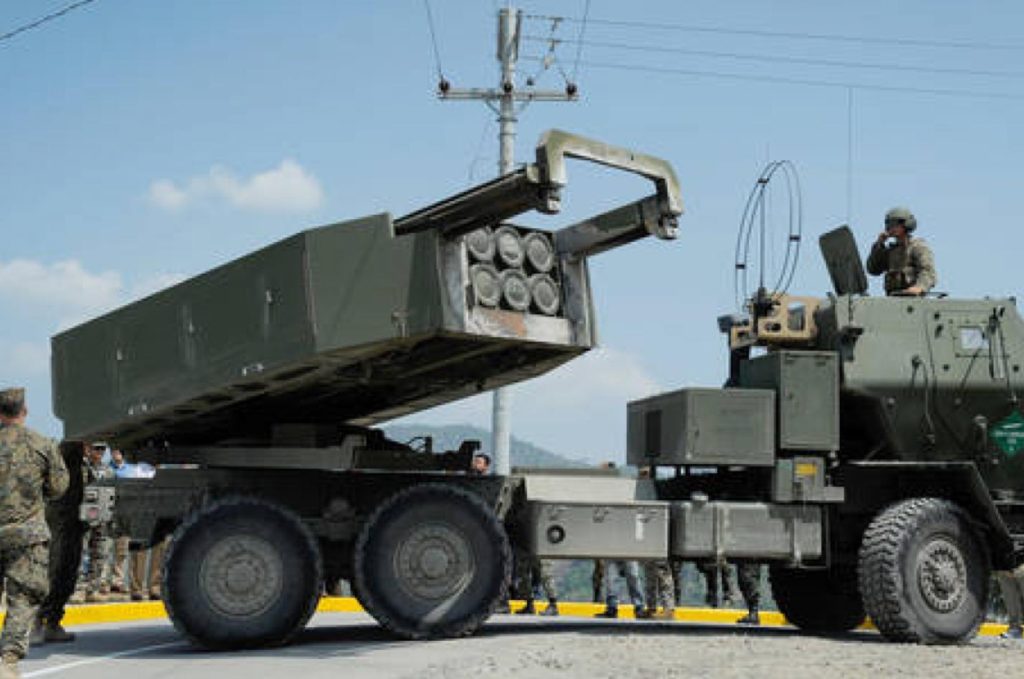
The US is sending Ukraine heavy guided missiles with a range of 70km for use with the HIMARS multiple rocket launchers, Undersecretary of Defense for Policy Colin Kahl revealed on Tuesday. The White House previously said that HIMARS launchers would be provided with “battlefield munitions,” widely understood to be unguided rockets with a shorter range.
The high-mobility artillery rocket system will come with GMLRS guided rockets, Kahl said on Tuesday, speaking at a conference hosted by the Center for New American Security (CNAS), a Democrat-linked think tank for which he used to work.
“Sometimes when you see images of MLRS firing off, it’s like salvos of multiple rockets going off at the same time. That’s really not how this system is meant to operate,” Kahl said.
“The GMLRS is a precision guided munition, and a big one – a 500 pound munition,” he added. “Think of GMLRS more like the effect of an airstrike rather than launching off whole salvos. So, in other words, you can do a lot with a little, or you don’t need a lot to have a significant effect.”
When the White House first announced it was sending HIMARS launchers to Ukraine on June 1, it said they would be armed with “battlefield munitions,” which was widely taken to mean barrage rockets with a range of between 32km and 60km, considering that HIMARS is also capable of launching ballistic projectiles with a range of up to 300km.
“The range does not depend on the system itself, but on the missiles that are used,” Russian President Vladimir Putin said in a TV interview earlier this month, adding that if the US sends long-range rockets Russia will “draw the appropriate conclusions and use our weapons, which we have enough of, in order to strike at those objects that we have not yet struck.”
Even though the US initially promised four launchers and said they had been “pre-positioned” in Europe, they have yet to reach Ukraine, according to the Pentagon. The first group of Ukrainian artillerists are currently finishing their training on the launchers, Kahl said.
The HIMARS launcher is equipped with one pod that can carry six GMLRS rockets, according to their maker, Lockheed Martin. The M270 launcher, which the UK has promised to Ukraine, carries two pods for double the payload. Kahl did not say how many rockets the US was sending.
According to the Russian Ministry of Defense, since the start of the conflict Ukraine has lost over 500 multiple rocket launch systems and more than 1,900 pieces of artillery. Kiev has beseeched its allies in the West to provide more weapons and ammunition.
“We’re going to provide the Ukrainians what they need to prosecute the targets inside Ukrainian territory that they’re looking to go after,” Kahl said at the end of his remarks about the HIMARS.
On Monday, the authorities in the Donetsk People’s Republic reported the heaviest Ukrainian shelling since 2015, with “indiscriminate” strikes on the city of Donetsk resulting in five fatalities and almost 40 civilian injuries. Among the incoming shells were 155mm munitions used by howitzers provided to Ukraine by the US and other NATO allies, authorities in the Donbass republic said, requesting additional military assistance from Russia.
Moscow has condemned the shelling of Donbass civilians as “absolutely barbaric.” A spokesman for the UN secretary-general called the shelling of a maternity hospital in Donetsk “an obvious breach of international humanitarian law.”
The USA is "doubling down" and "going for broke" totally and completely ignorant of the resultant consequences. -MM
House Democrats Propose 1,000% Tax On AR-15s
If you cannot ban something, you can place a large tax on it making it prohibitive to own. -MM
If Congress won’t ban AR-15s, Democratic Rep. Don Beyer (VA) wants to slap a 1,000% tax on them – which would of course mean only people with lots of money, such as drug dealers and rich people, could afford them, while punishing lower-income Americans.

Introduced last week, Beyer’s Assault Weapons Excise Act has 36 Democratic co-sponsors, according to the Washington Post. The group hopes the idea might bypass the Senate filibuster, which would require the support of at least 10 Republicans.
According to Beyer, the idea is to increase the price to such a degree that it significantly limits who’s able to buy them. The tax would also apply to high-capacity magazines.

“It’s trying to hit the sweet spot, where it’s not an all-out ban, but people’s independent purchasing decisions would be much more ‘no’ than ‘yes,’” Beyer told the Post, adding. “You want to shift the demand curve pretty significantly.”
Beyer said part of the thinking behind the 1,000 percent figure was to have a high-enough fiscal impact that the Senate parliamentarian would find it qualifies for inclusion in a reconciliation package, meaning it could pass the Senate with a simple majority. -WaPo
“In a nation crying out for progress on gun safety, we would present a plausible way forward in this Senate,” he said.
The tax would only apply to newly purchased guns, and would not apply to government buyers. The proceeds would go into the general fund.
As the Epoch Times notes, in an attempt to define what would be taxed, the bill says it would apply to “semiautomatic assault weapon[s],” which are semiautomatic rifles that have the capacity to use a magazine that isn’t a fixed magazine, a pistol grip, a forward grip, and a folding, telescoping, or detachable stock. Other items that fall under that definition include a semiautomatic rifle with a barrel shroud, a threaded barrel, and a “functional grenade launcher.”
The excise tax would also apply to “a semiautomatic rifle that has a fixed magazine with the capacity to accept more than 10 rounds, except for an attached tubular device designed to accept, and capable of operating only with, .22 caliber rimfire ammunition,” as well as certain semiautomatic pistols, all belt-fed semiautomatic rifles, shotguns with revolving cylinders, and more.
“Congress must take action to stem the flood of weapons of war into American communities, which have taken a terrible toll in Uvalde, Buffalo, Tulsa, and too many other places,” Beyer said in reference to widely reported mass shootings in recent weeks.
About half of all rifles manufactured in the United States or imported in 2018 were AR-15-style weapons, according to the National Shooting Sports Foundation trade group. The group said there are about 20 million of those firearms in circulation as of 2020.
United States rent costs are exploding!
Median rents in the US crossed the $2000 mark this past month for the first time ever, while rental markets surged 15% – 20% in a single year depending on the region.
This is yet another trend which supports the position that official CPI is inaccurate and overall inflation is actually much higher than the central bank and the Biden White House reports.
The latest CPI print indicates an “official” inflation rate of 8.6%, while REAL inflation is closer 17% according to pre-1990s calculations. The continued denial of real inflation rates is causing confusion among Americans who are facing vastly larger price increases than are often reported by the government.
Inflation apologists can’t seem to wrap their heads around the fact that the Fed and government use creative accounting to soften data and misrepresent the economic threat.
- Rent prices jumped over 20% in Orange County, CA.
- They are up 19.3% in the greater Cleveland area.
- They are up 15.5% in the Cincinnati area.
- Nashville and Seattle saw prices rise over 30%.
- And, Austin, TX is witnessing epic rental inflation of over 50%.
- New York’s median rent cost climbed to $4000 per month despite the fact that vast numbers of people have left the city in the course of the past two years.
Officials including Treasury Secretary Janet Yellen have only just recently admitted that inflation is not transitory as they had insisted a year ago. However, the public seems to be learning that establishment economic predictions cannot be trusted and they are already preparing for more pain in the near future. A George Mason University poll indicates that the majority of Americans are cutting back on spending to adapt to higher prices. Over 66% of participants polled expect inflation to climb even more this year.
Inflation worries have continued to soar over the past several months while the populace has dealt with constant gaslighting from the media telling them that the economic instability they are facing is “not something they should be concerned about.”
The relentless expansion of prices suggests that the Federal Reserve will enact sweeping interest rate hikes in the coming months, though there are many economists that continue to disbelieve the possibility. Even with moderate hikes and slower spending, it is likely that inflation will climb unabated well beyond 2022. Central bank stimulus printing has triggered an avalanche of too many dollars chasing too few goods and now prices are evolving to meet the supply crunch.
The rent inflation issue is partially influenced by a number of factors including the mass migration of millions of Americans from blue states where covid restrictions and high taxes were strangling residents. But, with that migration now over, prices remain high due to dollar devaluation pressures.
The greatest danger is that this will translate to increased poverty and homelessness by 2023.
It is unlikely that Fed actions on interest rates will affect any change in the current trend, at least not until rates are adjusted much higher than mainstream economists expect.
FCC Says Most Requests for Funds to Replace Chinese Telecom Equipment Are Deficient
Nothing better to do? Too much money no where to spend? WASHINGTON (Reuters) - The Federal Communications Commission (FCC) told Congress on Wednesday it had found deficiencies in two-thirds of applications to reimburse U.S. carriers for removing equipment from Chinese companies deemed national security threats. FCC Chair Jessica Rosenworcel said of 181 applications filed by mostly rural carriers under a $1.9 billion program, 122 were found to be "initially materially deficient." The FCC told applicants they have 15 days to fix their applications, and it "expects to complete this process by July 15." The FCC currently estimates the cost estimate to remove the equipment from companies like Huawei and ZTE Corp from the "rip and replace" program is $5.3 billion, much higher than what Congress set aside. In July 2021, the FCC voted to finalize the program that had been funded by Congress in December 2020. The FCC designated Huawei and ZTE as national security threats to communications networks in July 2020 - a declaration that barred U.S. firms from tapping an $8.3 billion government fund to purchase equipment from the companies. The FCC in December 2020 adopted rules requiring carriers with ZTE or Huawei equipment to "rip and replace" that equipment. The issue is a big one for rural carriers that face high costs and difficulty finding workers to remove and replace equipment. Huawei said last year the "FCC initiative only creates extraordinary challenges for carriers in the most rural/remote areas of the U.S. to maintain the same high level and quality of service they provide to their customers without disruption." Rosenworcel's letter noted the FCC "will allocate funding first to approved applications that have 2 million or fewer customers." She said to date "all but one of the eligible applicants falls within the first prioritization group, and the collective demand of these applicants exceeds available funds for the program." (Reporting by David Shepardson; Editing by Leslie Adler and Raju Gopalakrishnan)
How China is Winning Its Battle Against Air Pollution
Not at all reported in the Western media. -MM
National air pollution action plans devised by China have seen significant reductions in pollution levels and associated health risks.
China has lifted millions out of poverty like no other country on the planet. The price of that economic progress is demonstrated in the air pollution that has caused a public health crisis, killing more than 1.1 million people every year. It has also proved costly for the nation as the economy suffers an annual loss of $37 billion due to pollution-induced crop failure.
China Air Pollution Solutions
After Beijing’s ‘airpocalypse’ sparked a mass outpouring of anger and frustration among citizens, China set out to clean up the air quality of its cities. The government prohibited new coal-fired power plants and shut down a number of old plants in the most polluted regions including city clusters of Beijing-Tianjin-Hebei and the Pearl and Yangtze Deltas. Large cities like Shanghai, Shenzhen, and Guangzhou restricted the number of cars on the road and started introducing all-electric bus fleets. The country reduced its iron-and steel-making capacity and shut down coal mines. …
Reaching ‘Herd Immunity’ Is Unlikely in the U.S., Experts Now Believe
Ya think? -MM

Read paywall article HERE
New Hong Kong school textbooks say city was not a British colony
A fine neocon, anti-China publication. -MM
New textbooks sent to Hong Kong secondary schools teach that the city was not a British colony, but rather an occupied territory. Described (in the article) as a “recasting of history that is part of Beijing’s ideological clampdown in the city“.
Full article found HERE
Omm Sety – A British Woman Whose Life Was Lined by Reincarnation and Connected to a Pharaoh
When Dorothy Eady arrived to Egypt for the first time, it was obvious to her that she had been there before. But her last visit near the Nile may have taken place thousands of years earlier.
Dorothy was born on January 16, 1904 in the London suburb of Blackhearth. Doctors believed that she would not survive a terrible fall when she was three years old. However, it seems that the accident she faced was the beginning of her unbelievable life – a moment of opening the gate to the memories of a past life. Over the years, many skeptics tried to disprove Eady’s mystifying tale, but nobody could ever fully negate that she was one of pharaoh Seti I’s (c. 1290 – 1279 BC) lovers.
An Ancient King’s Lover?
Dorothy grew up in a Christian family and she attended church regularly when she was young. One day, her parents took her to the British Museum. While looking at the photograph of the temple of Seti I, a pharaoh of the 19th dynasty of the New Kingdom Period (and the father of Rameses II), she said that it was her home. She couldn’t understand why there were no gardens and trees around the temple, but she recognized the monuments and other artifacts in the rooms of the Egyptian collection. She kissed the feet of the statues, and very soon after, decided to study ancient Egyptian hieroglyphs.
One of her teachers was the famous E.A. Wallis Budge, who encouraged her to study the history of ancient Egypt. Dorothy was 15 years old when she described the first dream “meeting” she had with the mummy of Pharaoh Seti I. She claimed that he made her remember her past life. With time, she turned more and more to the ancient religion and stopped feeling attached to Christianity.
Dorothy married the Egyptian Eman Abdel Meguid in 1931. This marriage was like a ticket to her beloved Egypt, where she became an English teacher. When her feet touched Egypt’s land for the first time she kissed the ground and felt like she was welcomed by her old home. She had a son who she called Sety. In this period, she reported having visions related to Hor-Ra. She also discovered her ancient Egyptian name – Bentreshyt meaning ‘Harp of Joy.’ In her visions she also saw her ancient family.
Dorothy said that she was a daughter of one of Seti I’s soldiers and a woman who sold vegetables. Her mother died when she was three years old, and she was given to the temple in Abydos, where she grew up and became a priestess. At 12 years old, she claimed she became a consecrated virgin, but a few years later she met ‘a living god’ – pharaoh Seti I. They became lovers, and Bentreshyt got pregnant. Unfortunately, the lovers’ fate was not a happy one. The High Priest of the temple told her that the situation was a huge offense against Isis and would cause many problems for pharaoh, so she decided to commit suicide.
The Eternal City of Abydos
After 19 years of living in Cairo, Dorothy Eady decided to move to Abydos. She was 52 years old, and she set up a home near the mountain Pega-the-Gap. According to ancient beliefs, it was a mountain which was the road to the afterlife. At this stage of life, she started to be called Omm Sety , meaning ”mother of Sety”.
Omm Sety believed she was finally back home. During one of her visits to the temple, the chief inspector from the Antiquities Department decided to check her knowledge. He was curious how realistic her explanations were. Dorothy was asked to stand next to the wall paintings in the darkness. She was then asked to identify them with what she remembered from her past life.
When Eady accomplished the task without any mistakes, many people stopped doubting her story. Her life in Abydos was full of collaborations with Egyptologists who asked her for support. She published several books on her own, but also joined the works of other researchers. The most important subject of her works was, of course, the Temple of Seti I at Abydos. She helped to discover the garden, where she believed she met Seti I for the first time. The excavations uncovered the space, which would have looked exactly as she described during ancient times.
Eady also told other researchers what the prayers and traditional rituals looked like. She knew the plot of many religious papyri even before she read them. Her descriptions of the monuments, reliefs, and other things she saw during her previous life were repeatedly confirmed by excavations.
Researchers Couldn’t Believe it
Moreover, many Egyptologists couldn’t negate her words. Eady had knowledge which was not available to specialists who had worked in Egypt for many years.
One of them is famous British Egyptologist Kenneth Kitchen. Although he did not want to openly admit it, written resources suggest that he believed her.
Nicholas Reeves also took her visions into account while searching for Nefertiti. According to Eady, the tomb is in the Valley of the Kings. She said:
''I did once ask His Majesty where it was, and he told me. He said, `Why do you want to know’? I said I would like to have it excavated, and he said, `No, you must not. We don’t want anything more of this family known`. But he did tell me where it was, and I can tell you this much. It’s in the Valley of the Kings, and it’s quite near to the Tutankhamun tomb. But it’s in a place where nobody would ever think of looking for it," she laughed. "And apparently it is still intact" ... ''
For decades, Eady was an inspiration to many researchers. Her stories about life and death in the times of Seti I touched many hearts as well. Many discoveries were made based on her words. Following her information, researchers led by Otto Schaden discovered tomb KV63 in the Valley of the Kings, which is located near the tomb of Tutankhamun and contained burials of women from the times of the 18th dynasty.
A Reunion of Two Souls
Dorothy Eady died at age 81 and was buried in the Coptic cemetery in Abydos. She believed that death would allow her to reconnect with her beloved. Even now, researchers are still trying to prove that she was she a liar, who had somehow gotten access to the newest literature and had great acting skills. But others say that she was one of the most fascinating people they have ever met.
Russia Cuts Natural Gas by 40% to Germany and Italy – Pump failures
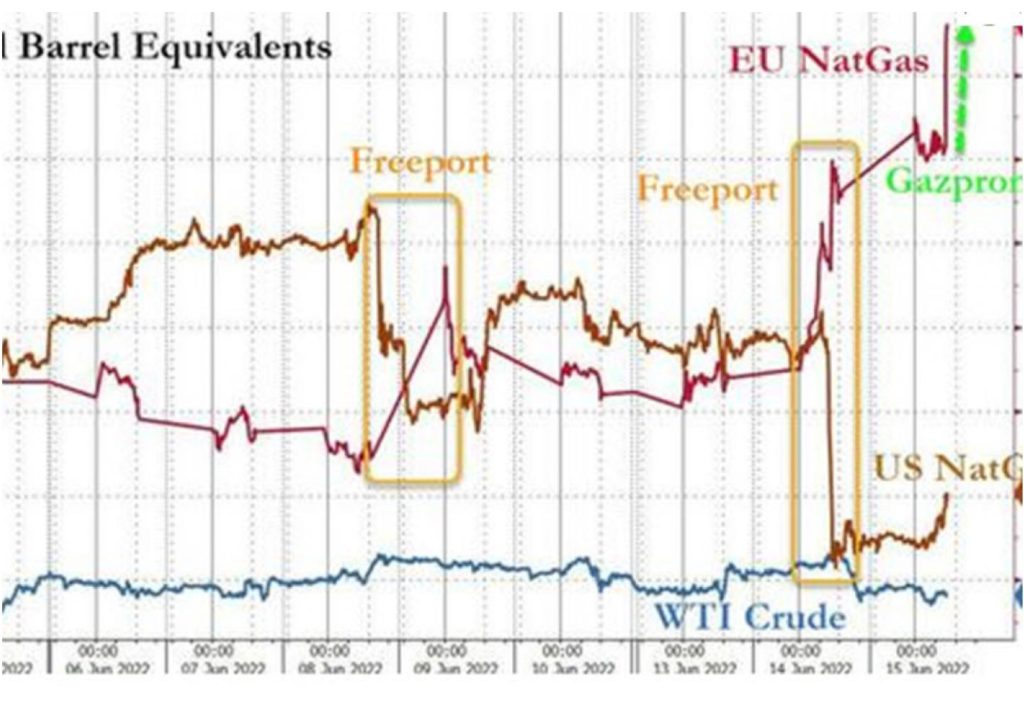
Russia’s state-owned natural gas company, GAZPROM has been forced to reduce pumping of natural gas through the Nord Stream pipeline into German and Italy by 40% because Canada will NOT return a remanufactured gas compressor pump from Montreal, on account of economic sanctions.
The remaining pumps on the Nord Stream pipeline cannot continue to handle the full load of 167 million cubic meters of gas per day, and must be scaled back to have continued service life.
Siemans Energy said a gas turbine which powers a compressor station on the Nord Stream pipeline, had been in service for more than ten years. It had been taken to Montreal for a scheduled overhaul.
Because of economic sanctions imposed by Canada, the company has been unable to return the overhauled turbine to the customer, GAZPROM.
Thus, Europe as a whole will only be able to get 100 million cubic meters of natural gas per day, instead of its needed 167 million per day.
The price for European natural gas is surging this morning because of the forty percent cut by Russia.
Russian gas supply to Europe fell further on Thursday, sparking concerns about refilling storage for winter….
diplomatic tussle as Gazprom blames Western sanctions for hampering maintenance work…
►Supply via Nord Stream 1 to Germany cut to 40% capacity
►Europe’s benchmark gas price jumps 25% in morning trade
Gazprom cutting supply to Germany is a warning signal that could cause problems for Europe’s biggest economy this winter.
“It would significantly worsen our situation,” Klaus Mueller told the Rheinische Post daily. “We could perhaps get through the summer as the heating season is over. But it is imperative that we fill the storage facilities to get through the winter.”
The cuts come as Nord Stream 1 is set to undergo annual maintenance on July 11-21 when supply will be cut off completely.
HAL TURNER EDITORIAL OPINION
Once again, western economic sanctions imposed against Russia, backfire and harm only the west.
It should be noted that recently, German Chancellor Scholz publicly stated Germany was going to rebuild its army into the largest army in Europe; something that hasn’t happened since the time of Hitler.
One wonders how Germany plans to build that army when it doesn’t have enough natural gas supply to even run the country?
The people imposing these economic sanctions against Russia really do seem to me, to be a special kind of stupid.
U.S. Army Engineers Are Racing to Build Hypersonic Weapons
A fine neocon, anti-China publication. -MM
Hypersonic weapons are now being fired from U.S. Air Force planes and U.S. Army ground launchers while also being fast-tracked to fire from U.S. Navy destroyers by 2025 and submarines by 2028. These technological breakthroughs are already reshaping warfare tactics and concepts of operation.
Projectiles that skip along the upper boundary of the earth’s atmosphere and descend upon targets at more than five times the speed of sound are no longer a “concept” for the future. The U.S. military is already in the process of arming major platforms with them. The U.S. Air Force, for example, has already fired its Air-Launched Rapid Response hypersonic weapon from a B-52 Stratofortress.
What about hypersonic weapons ten or twenty years from now? What will they consist of? How fast will they fire? Will they maneuver in flight, perhaps traveling at now unimagined speeds?
These questions are now being explored through cutting-edge basic research efforts at the Army Research Laboratory, where teams of engineers and scientists are experimenting with mixtures of ceramic, metal, polymer, and composite materials at the microscopic level to uncover better performing materials to engineer the weapons of the future. While the work could yield near-term applications in the event of breakthrough testing, much of the exploration is aimed at uncovering “disruptive” or paradigm-changing scientific breakthroughs.
Specific materials built into weapons systems bring distinct properties such as being lighter in weight, more resistant to penetration or better equipped to maneuver and manage accurate flight at previously unimaginable temperatures.
Nicholas Ku, a materials engineer working for the Ceramic and Transparent Materials Branch at DEVCOM Army Research Laboratory spends his time mixing, testing, heating, and experimenting with different combinations of materials in search of breakthrough discoverings.
“Ceramics are of interest for hypersonics applications, through the way additive manufacturing has an ability to create complex shapes, decrease manufacturing costs as well as increase the design space in making new components,” Ku said.
Ku was clear that much of the work involves simply creating different combinations and layers of materials. The process is called “additive manufacturing,” and Ku and other ARL scientists use it to uncover new materials for armored vehicles, body armor, and projectiles such as hypersonics. Ku explained that traditional methods of manufacturing greatly limit the complexity of the design when compared with options made available through additive manufacturing, a circumstance that introduces new dimensions of possibility.
“By enabling additive manufacturing of these materials, we can increase the design space,” Ku said.
The shape and composition of a hypersonic projectile determine key aerodynamic and performance variables of great consequence. Will yet-to-be-discovered materials will enable new hypersonic structures to travel as much as two or three times as fast as existing hypersonic projectiles? Perhaps new materials can enable a hypersonic weapon to achieve previously unprecedented precision flight path and targeting.
The rest of the Article HERE in this Neocon publication
Slow-Cooker Pork Chops with Apple Chutney
Pork and apples have long been perfect partners. Dried cranberries add color and tartness.



The ‘New G8’ Meets China’s ‘Three Rings’
The G7 is falling into dust, while a new group; the G8 rises. -MM
The coming of the new G8 points to the inevitable advent of BRICS +, one of the key themes to be discussed in the upcoming BRICS summit in China.
By Pepe Escobar, posted with the author’s permission and widely cross-posted
The speaker of the Duma, Vyacheslav Volodin, may have created the defining acronym for the emerging multipolar world: “the new G8”.
As Volodin noted, “the United States has created conditions with its own hands so that countries wishing to build an equal dialogue and mutually beneficial relations will actually form a ‘new G8’ together with Russia.”
This non Russia-sanctioning G8, he added, is 24.4% ahead of the old one, which is in fact the G7, in terms of GDP in purchasing power parity (PPP), as G7 economies are on the verge of collapsing and the U.S. registers record inflation.
The power of the acronym was confirmed by one of the researchers on Europe at the Russian Academy of Sciences, Sergei Fedorov: three BRICS members (Brazil, China and India) alongside Russia, plus Indonesia, Iran, Turkey and Mexico, all non adherents to the all-out Western economic war against Russia, will soon dominate global markets.
Fedorov stressed the power of the new G8 in population as well as economically: “If the West, which restricted all international organizations, follows its own policies, and pressures everyone, then why are these organizations necessary? Russia does not follow these rules.”
The new G8, instead, “does not impose anything on anyone, but tries to find common solutions.”
The coming of the new G8 points to the inevitable advent of BRICS +, one of the key themes to be discussed in the upcoming BRICS summit in China. Argentina is very much interested in becoming part of the extended BRICS and those (informal) members of the new G8 – Indonesia, Iran, Turkey, Mexico – are all likely candidates.
The intersection of the new G8 and BRICS + will lead Beijing to turbo-charge what has already been conceptualized as the Three Rings strategy by Cheng Yawen, from the Institute of International Relations and Public Affairs at the Shanghai International Studies University.
Cheng argues that since the beginning of the 2018 U.S.-China trade war the Empire of Lies and its vassals have aimed to “decouple”; thus the Middle Kingdom should strategically downgrade its relations with the West and promote a new international system based on South-South cooperation.
Looks like if it walks and talks like the new G8, that’s because it’s the real deal.
The revolution reaches the “global countryside”
Cheng stresses how “the center-periphery hierarchy of the West has been perpetuated as an implicit rule” in international relations; and how China and Russia, “because of their strict capital controls, are the last two obstacles to further U.S. control of the global periphery”.
So how would the Three Rings – in fact a new global system – be deployed?
The first ring “is China’s neighboring countries in East Asia, Central Asia, and the Middle East; the second ring is the vast number of developing countries in Asia, Africa, and Latin America; and the third ring extends to the traditional industrialized countries, mainly Europe and the United States.”
The basis for building the Three Rings is deeper Global South integration. Cheng notes how “between 1980-2021, the economic volume of developing countries rose from 21 to 42.2 percent of the world’s total output.”
And yet “current trade flows and mutual investments of developing countries are still heavily dependent on the financial and monetary institutions/networks controlled by the West. In order to break their dependence on the West and further enhance economic and political autonomy, a broader financial and monetary cooperation, and new sets of instruments among developing countries should be constructed”.
This is a veiled reference to the current discussions inside the Eurasia Economic Union (EAEU), with Chinese participation, designing an alternative financial-monetary system not only for Eurasia but for the Global South – bypassing possible American attempts to enforce a sort of Bretton Woods 3.0.
Cheng uses a Maoist metaphor to illustrate his point – referring to ‘the revolutionary path of ‘encircling the cities from the countryside’”. What is needed now, he argues, is for China and the Global South to “overcome the West’s preventive measures and cooperate with the ‘global countryside’ – the peripheral countries – in the same way.”
So what seems to be in the horizon, as conceptualized by Chinese academia, is a “new G8/BRICS+” interaction as the revolutionary vanguard of the emerging multipolar world, designed to expand to the whole Global South.
That of course will mean a deepened internationalization of Chinese geopolitical and geoeconomic power, including its currency. Cheng qualifies the creation of a “three ring “ international system as essential to “break through the [American] siege”.
It’s more than evident that the Empire won’t take that lying down.
The siege will continue. Enter the Indo-Pacific Economic Framework (IPEF), spun as yet another proverbial “effort” to – what else – contain China, but this time all the way from Northeast Asia to Southeast Asia, with Oceania thrown in as a bonus.
The American spin on IPEF is heavy on “economic engagement”: fog of (hybrid) war disguising the real intent to divert as much trade as possible from China – which produces virtually everything – to the U.S. – which produces very little.
The Americans give away the game by heavily focusing their strategy on 7 of the 10 ASEAN nations – as part of yet another desperate dash to control the American-denominated “Indo-Pacific”. Their logic: ASEAN after all needs a “stable partner”; the American economy is “comparatively stable”; thus ASEAN must subject itself to American geopolitical aims.
IPEF, under the cover of trade and economics, plays the same old tune, with the U.S. going after China from three different angles.
- – The South China Sea, instrumentalizing ASEAN.
- – The Yellow and East China Seas, instrumentalizing Japan and South Korea to prevent direct Chinese access to the Pacific.
- – The larger “Indo-Pacific” (that’s were India as a member of the Quad comes in).
It’s all labeled as a sweet apple pie of “stronger and more resilient Indo-Pacific with diversified trade.”
BRI corridors are back
Beijing is hardly losing any sleep thinking about IPEF: after all most of its multiple trade connections across ASEAN are rock solid. Taiwan though is a completely different story.
At the annual Shangri-La dialogue this past weekend in Singapore, Chinese Defense Minister Wei Fenghe went straight to the point, actually defining Beijing’s vision for an East Asia order (not “rules-based”, of course).
Taiwan independence is a “dead end”, said General Wei, as he asserted Beijing’s peaceful aims while vigorously slamming assorted U.S. “threats against China”. At any attempt at interference, “we will fight at all costs, and we will fight to the very end”. Wei also handily dismissed the U.S. drive to “hijack” Indo-Pacific nations, without even mentioning IPEF.
China at it stands is firmly concentrated on stabilizing its western borders – which will allow it to devote more time to the South China Sea and the “Indo-Pacific” further on down the road.
Chinese Foreign Minister Wang Yi went on a crucial trip to Kazakhstan – a full member of both BRI and the EAEU – where he met President Kassym-Jomart Tokayev and all his counterparts from the Central Asian “stans” in a summit in Nur-Sultan. The group – billed as C+C5 – discussed everything from security, energy and transportation to Afghanistan and vaccines.
In sum, this was all about developing much-needed corridors of BRI/ New Silk Roads – in sharp contrast to the proverbial Western lamentations about BRI reaching a dead end.
Two BRI-to-the-bone projects will go on overdrive: the China-Central Asia Gas Pipeline Line D, and the China-Kyrgyzstan-Uzbekistan railway. Both have been years in the making, but now have become absolutely essential, and will be the flagship BRI projects in the Central Asian corridor.
The China-Central Asia Gas Pipeline Line D will link Turkmenistan’s gas fields to Xinjiang via Uzbekistan, Tajikistan and Kyrgyzstan. That was the main theme of the discussions when Turkmen President Berdimuhamedow visited Beijing for the Winter Olympics.
The 523 km China-Kyrgyzstan-Uzbekistan railway for its part will crucially link the two Central Asian “stans” to the China-Europe freight rail network, via the existing rail networks in Turkmenistan.
Considering the current incandescent geopolitical scenario in Ukraine, this is a bombshell in itself, because it will enable freight from China to travel via Iran or via Caspian ports, bypassing sanctioned Russia. No hard feelings, in terms of the Russia-China strategic partnership: just business.
The Kyrgyz, predictably, were ecstatic. Construction begins next year. According to Kyrgyz President Zhaparov, “there will be jobs. Our economy will boom.”
Talk about China acting decisively in its “first ring”, in Central Asia. Don’t expect anything of such geoeconomic breadth and scope being “offered” by IPEF anywhere in ASEAN.
European Central Bank Calls Emergency Meeting; EURO Headed to valuation less than $1
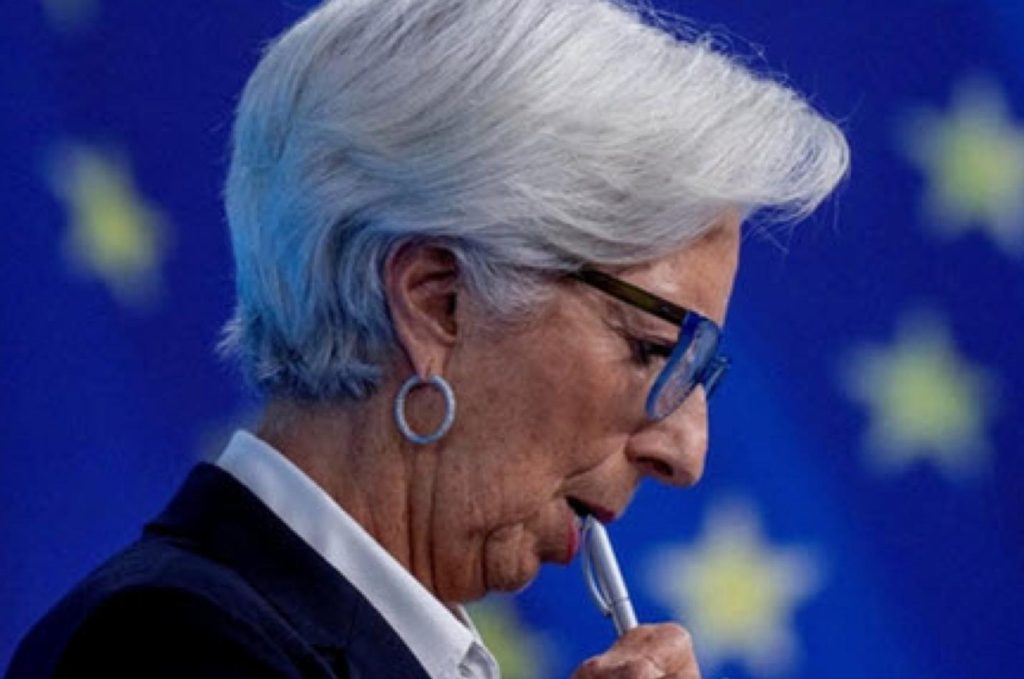
The European Central Bank has called an Emergency meeting because the value of the EURO is sliding downward (fast) and looks to be worth less than one US Dollar very soon.
Countries around the world have begun unloading their supplies of EUROS because decisions made by Europe against Russia, show that Europe will not have much of a manufacturing base, or be able to sustain value of their currency much longer.
Europe’s reliance upon Russian gas and oil, and subsequent embargo of its own energy supplies in an effort to “sanction” Russia, is backfiring on Europe in an extraordinary way.
Put simply, Europe is cutting its own throat economically by embargoing Russian gas and oil. Without cheap and plentiful energy, Europe cannot have industry. Without industry, Europe cannot pay its bills and will collapse.
Rather than wait, countries around the world are lessening their supplies of EUROS, causing the value of that currency to drop against the US dollar.
Wells Fargo Bank in the U.S. made clear yesterday, they believe the EURO will fall to a value less than one US Dollar within a month:

Strawberry Streusel Bars
This sweet streusel-topped strawberry cookie bar is the perfect treat for summertime.



If The Streets Of America Are This Chaotic Now, What Will They Be Like When Things Really Start Hitting The Fan?
Authored by Michael Snyder via The End of The American Dream blog,
If you are not alarmed by what is happening to our largest cities, you should check to see if you still have a pulse. Once upon a time, the beautiful new cities that our forefathers constructed were the envy of the entire planet, but now many of them have degenerated into crime-infested hellholes that are absolutely teeming with violent predators. Shoplifting has essentially become a national pastime, open air drug markets operate freely right under the noses of indifferent authorities, and addicts pull down their pants and take a dump whenever and wherever they feel like doing so. Thanks to record levels of illegal immigration, gang membership is absolutely exploding, and human trafficking has reached truly frightening levels. Of course our steadily thinning police forces are overwhelmed at this point. In fact, police in Seattle are stretched so thin that they often are not able “to take reports from rape victims”. And if you are the victim of a non-violent crime in Seattle, good luck ever getting a police officer to pay attention to your case. From coast to coast, communities are descending into a state of utter lawlessness. So if things are this bad already, what will conditions be like when things really start hitting the fan?
Continuing a trend that we have seen for the last couple of years, crime rates all over the nation just keep going higher and higher.
For example, auto theft, grand larceny and transit crime are all up by more than 50 percent in New York City so far this year…
Data released by the New York City Police Department showed Grand Larceny Auto increased by 51.1% with 5,420 incidents as of June 5 compared to just 3,587 incidents by the same time in 2021. That category had one of the largest upticks during the most recent crime statistic report covering May 30 to June 5. Grand larceny incidents spiked by 50.1% from 20,659 incidents reported to NYPD as of June 5, compared to the 13,713 reported during the same period last year. Meanwhile, overall transit crime surged by 53.6% so far this year.
I thought that the new mayor was elected to end the crime wave.
Instead, it appears that it has been supersized.
One way to hide the rapid rise in crime is to decriminalize things that used to be major offenses.
In Portland, voters decided to decriminalize hard drugs, but that just turned the city into an “open air drug market”…
The streets of Portland resemble an ‘open air drug market’ after state officials’ scheme to decriminalize hard drugs led to a surge in overdose deaths, critics claim. Law enforcement agents say that the streets of Portland are full of homeless addicts openly buying and selling drugs and that signs of drug addiction are actually increasing statewide, Fox News reported. Photos show the desperate situation in the liberal Pacific Northwest city, where people can be seen shooting up drugs or passed out in broad daylight.
At one time, Portland was one of the most magnificent cities in the entire world.
Now it is a horror show.
On top of all the ordinary crime that is going on, now we are witnessing a very alarming rise in politically-motivated violence.
The Supreme Court decision that will overturn Roe v. Wade is expected to be released this month, and a group known as “Jane’s Revenge” has announced that it is “open season” on those with pro-life views…
The pro-abortion group Jane’s Revenge is declaring it “open season” on pro-life groups and crisis pregnancy centers. The group has a history of damaging property during their protests, and they took credit for the vandalization of a pregnancy resource center in Des Moines, Iowa earlier this month. In a message posted to social media, the group said they broke windows and left graffiti political messages all over the clinic. “It was easy and fun,” the message read.
Sadly, even though the official Supreme Court decision has not even been released yet, there has already been quite a bit of violence.
In fact, it is being reported that there have been more than three dozen attacks on pro-life groups, churches and crisis pregnancy centers in recent weeks…
An armed would-be assassin’s alleged attempt on the life of Supreme Court Justice Brett Kavanaugh last week is part of a wave of violence, arson, vandalism, and intimidation targeting pro-life groups and government officials since the leak last month of a draft Supreme Court opinion that would overturn Roe v. Wade. There have been more than three dozen such incidents directed at crisis pregnancy centers and churches in at least 20 states and Washington, D.C., according to a tally maintained by LifeNews.com, an anti-abortion site.
The thin veneer of civilization that we all take for granted on a daily basis is rapidly dissipating, and our streets are becoming more uncivilized with each passing day.
If this is happening while economic conditions are still relatively stable, what will happen once things start getting really crazy out there?
In some parts of the world, the food crisis has already reached critical levels. For example, the government of Sri Lanka has actually shortened the work week so that workers will have more time to grow their own food…
Sri Lanka’s federal government on Monday approved a proposal that would shorten the work week of most public sector staff to four days so that workers will have time to farm their own crops, Reuters reported Tuesday, noting the measure aims to combat Sri Lanka’s worsening food shortages caused by a recent economic crisis. “Sri Lanka’s Cabinet late on Monday approved a proposal for public sector workers to be given leave every Friday for the next three months, partly because the fuel shortage made commuting difficult and also to encourage them to farm,” Reuters reported on June 14.
Over in Africa, the United Nations has stopped feeding approximately 1.7 million citizens of South Sudan because they simply do not have enough funding to feed the rapidly growing throngs of desperately hungry people…
The World Food Programme has been forced to stop providing food aid to around 1.7 million people in South Sudan, because of a lack of funding. The UN-run organization will still reach 4.5 million people, but many will miss out on vital resources. According to BBC News, over half the population of South Sudan is currently facing hunger due to floods, localized drought, continuing conflict, and rising food prices. Marwa Awad is from the World Food Programme and is in the northern town of Bentiu in South Sudan, where she has been talking to people about the effects the cuts to aid are having.
All of the experts are telling us that the global food crisis is going to get a lot worse as the months roll along.
If the UN has already reached the limit of what they are able to do, who is going to help the millions upon millions of hungry people that will soon need help in order to survive?
Here in the U.S., food production has been affected by a bizarre series of disasters, and we are being warned that much less will be produced this year than originally anticipated. I think that one expert summed up the current situation very well when he warned that “we are teetering on the edge right now”…
Pennsylvania farmers are being “crushed” by the record cost of diesel – so much so, that questions about a food crisis are starting to loom, the Morning Call reported. One farmer in Lehigh County is quoted as saying: “I’ve got a tractor hooked up to my corn planter out here, no diesel fuel, and I can’t afford to get any.” That farmer was airing his gripes to Kyle Kotzmoyer, a legislative affairs specialist for the Pennsylvania Farm Bureau. Kotzmoyer then turned around and testified to state lawmakers: “We have reached that point to where it is very close to being a sinking ship. We are teetering on the edge right now.”
If we eventually get to a point where food prices spiral completely out of control and there are widespread shortages, do you think that those living in our core urban areas will respond with grace and patience?
Of course not.
Instead, people will go absolutely nuts.
We got a small preview of what is to come during the Arab Spring of 2011. There were serious food shortages around the world that year, and that resulted in tremendous civil unrest.
Here in the United States, most people do not have large amounts of food stored up, and that is especially true in our largest cities.
So we better hope that the rapidly growing global food crisis does not affect us too severely, because the truth is that we are definitely not equipped to handle such a scenario.
An American “Green Revolution”
This is out of Australia.They are discussing the outrageous costs that are going ballistic inside the United States.
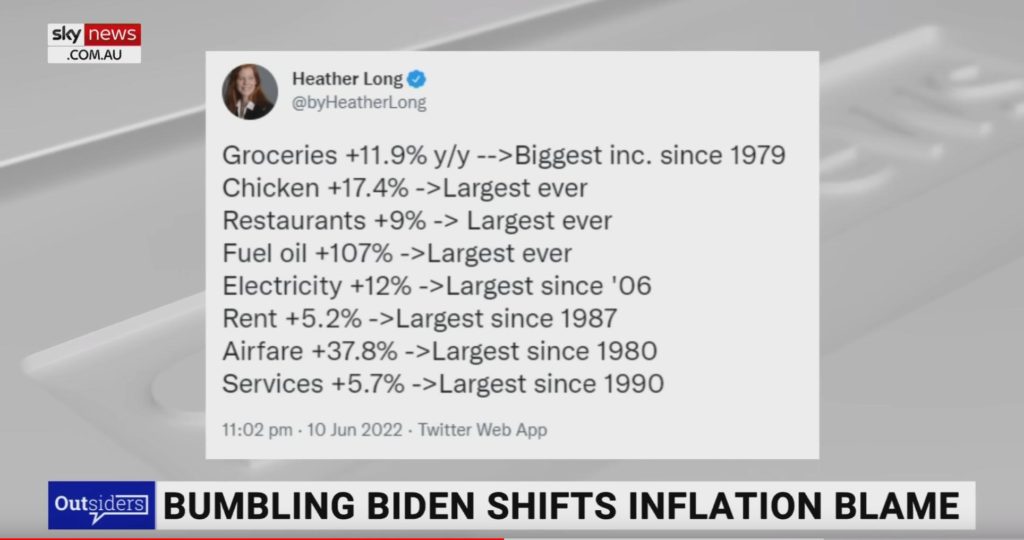
Everyone can see…
The Engineered Stagflationary Collapse Has Arrived – Here’s What Happens Next
Authored by Brandon Smith via Alt-Market.us
In my 16 years as an alternative economist and political writer I have spent around half that time warning that the ultimate outcome of the Federal Reserve’s stimulus model would be a stagflationary collapse. Not a deflationary collapse, or an inflationary collapse, but a stagflationary collapse. The reasons for this were very specific – Mass debt creation was being countered with MORE debt creation while many central banks have been simultaneously devaluing their currencies through QE measures. On top of that, the US is in the unique position of relying on the world reserve status of the dollar and that status is diminishing.
It was only a matter of time before the to forces of deflation and inflation met in the middle to create stagflation. In my article ‘Infrastructure Bills Do Not Lead To Recovery, Only Increased Federal Control’, published in April of 2021, I stated that:
“Production of fiat money is not the same as real production within the economy… Trillions of dollars in public works programs might create more jobs, but it will also inflate prices as the dollar goes into decline. So, unless wages are adjusted constantly according to price increases, people will have jobs, but still won’t be able to afford a comfortable standard of living. This leads to stagflation, in which prices continue to rise while wages and consumption stagnate. Another Catch-22 to consider is that if inflation becomes rampant, the Federal Reserve may be compelled (or claim they are compelled) to raise interest rates significantly in a short span of time. This means an immediate slowdown in the flow of overnight loans to major banks, an immediate slowdown in loans to large and small businesses, an immediate crash in credit options for consumers, and an overall crash in consumer spending. You might recognize this as the recipe that created the 1981-1982 recession, the third-worst in the 20th century. In other words, the choice is stagflation, or deflationary depression.”
It’s clear today what the Fed has chosen. It’s important to remember that throughout 2020 and 2021 the mainstream media, the central bank and most government officials were telling the public that inflation was “transitory.” Suddenly in the past few months this has changed and now even Janet Yellen has admitted that she was “wrong” on inflation. This is a misdirection, however, because the Fed knows exactly what it is doing and always has. Yellen denied reality, but she knew she was denying reality. In other words, she was not mistaken about the economic crisis, she lied about it.
As I outlined last December in my article ‘The Fed’s Catch-22 Taper Is A Weapon, Not A Policy Error’:
‘First and foremost, no, the Fed is not motivated by profits, at least not primarily. The Fed is able to print wealth at will, they don’t care about profits – They care about power and centralization. Would they sacrifice “the golden goose” of US markets in order to gain more power and full bore globalism? Absolutely. Would central bankers sacrifice the dollar and blow up the Fed as an institution in order to force a global currency system on the masses? There is no doubt; they’ve put the US economy at risk in the past in order to get more centralization.’
The Fed has known for years that the current path would lead to inflation and then market destruction, and here’s the proof – Fed Chairman Jerome Powell actually warned about this exact outcome in October of 2012:
“I have concerns about more purchases. As others have pointed out, the dealer community is now assuming close to a $4 trillion balance sheet and purchases through the first quarter of 2014. I admit that is a much stronger reaction than I anticipated, and I am uncomfortable with it for a couple of reasons.First, the question, why stop at $4 trillion? The market in most cases will cheer us for doing more. It will never be enough for the market. Our models will always tell us that we are helping the economy, and I will probably always feel that those benefits are overestimated. And we will be able to tell ourselves that market function is not impaired and that inflation expectations are under control. What is to stop us, other than much faster economic growth, which it is probably not in our power to produce? When it is time for us to sell, or even to stop buying, the response could be quite strong; there is every reason to expect a strong response. So there are a couple of ways to look at it. It is about $1.2 trillion in sales; you take 60 months, you get about $20 billion a month. That is a very doable thing, it sounds like, in a market where the norm by the middle of next year is $80 billion a month. Another way to look at it, though, is that it’s not so much the sale, the duration; it’s also unloading our short volatility position.”
As we all now know, the Fed waited until their balance sheet was far larger and until the economy was MUCH weaker than it was in 2012 to unleash tightening measures. They KNEW the whole time exactly what was going to happen.
It is no coincidence that the culmination of the Fed’s stimulus bonanza has arrived right after the incredible damage done to the economy and the global supply chain by the covid lockdowns. It is no coincidence that these two events work together to create the perfect stagflationary scenario. And, it’s no coincidence that the only people who benefit from these conditions are proponents of the “Great Reset” ideology at the World Economic Forum and other globalist institutions. This is an engineered collapse that has been in the works for many years.
The goal is to “reset” the world, to erase what’s left of free market systems, and to establish what they call the “Shared Economy” system. This system is one in which the people who survive the crash will be made utterly dependent on government through Universal Basic Income and one that will restrict all resource usage in the name of “carbon reduction.” According to the WEF, you will own nothing and you will like it.
The collapse is engineered to create crisis conditions so frightening that they expect the majority of the public to submit to a collectivist hive mind lifestyle with greatly reduced standards. This would be accomplished through UBI, digital currency models, carbon taxation, population reduction, rationing of all commodities and a social credit system. The goal, in other words, is complete control through technocratic authoritarianism.
All of this is dependent on the exploitation of crisis events to create fear in the population. Now that economic destabilization has arrived, what happens next? Here are my predictions…
The Fed Will Hike Interest Rates More Than Expected, But Not Enough To Stop Inflation
Today, we are witnessing the poisonous fruits of a decade-plus of massive fiat money creation and we are now at the stage where the Fed will reveal its true plan. Hiking interest rates fast, or hiking them slow. Fast hikes will mean an almost immediate crash in markets (beyond what we have already seen), slow hikes will mean a drawn out process of price inflation and general uncertainty.
I believe the Fed will hike more than expected, but not enough to actually slow inflation in necessities. There will be an overall decline in luxury items, recreation commerce and non-essentials, but most other goods will continue to climb in cost. It is to the advantage of globalists to keep the inflation train running for another year or longer.
In the end, though, the central bank WILL declare that the pace of interest rates is not enough to stop inflation and they will revert to a Volcker-like strategy, pushing rates up so high that the economy simply stops functioning altogether.
Markets Will Crash And Unemployment Will Abruptly Spike
Stock markets are utterly dependent on Fed stimulus and easy money through low interest rate loans – This is a fact. Without low rates and QE, corporations cannot engage in stock buybacks. Meaning, the tools for artificially inflating equities are disappearing. We are already seeing the effects of this now with markets dropping 20% or more.
The Fed will not capitulate. They will continue to hike regardless of the market reaction.
As far as jobs are concerned, Biden and many mainstream economists constantly applaud the low unemployment rate as proof that the American economy is “strong,” but this is an illusion. Covid stimulus measures temporarily created a dynamic in which businesses needed increased staff to deal with excess retail spending. Now, the covid checks have stopped and Americans have maxed out their credit cards. There is nothing left to keep the system afloat.
Businesses will start making large job cuts throughout the last half of 2022.
Price Controls
I have no doubt that Joe Biden and Democrats will seek to enforce price controls on many goods as inflation continues, and there will be a handful of Republicans that will support the tactic. Price controls actually lead to a reduction in supply because they remove all profits and thus all incentive for manufacturers to keep producing goods. What usually happens at that point is government steps in to nationalize manufacturing, but this will be substandard production and at a much lower yield.
In the end, supplies are reduced even further and prices go even higher on the black market because no one can get their hands on most goods anyway.
Rationing
Yes, rationing at the manufacturing and distribution level is going to happen, so be sure to buy what you need now before it does. Rationing occurs in the wake of price controls or supply chain disruptions, and usually this coincides with a government propaganda campaign against “hoarders.”
They will hold up a few exaggerated examples of people who buy truckloads of merchandise to scalp prices on the black market. Then, not long after, they will accuse preppers and anyone who bought goods BEFORE the crisis of “hoarding” simply because they planned ahead.
Rationing is not only about controlling the supply of necessities and thus controlling the population by proxy; it is also about creating an atmosphere of blame and suspicion within the public and getting them to snitch on or attack anyone that is prepared. Prepared people represent a threat to the establishment, so expect to be demonized in the media and organize with other prepared people to protect yourself.
Be Ready, It Only Gets Worse From Here On
It might sound like I am predicting success of the Great Reset program, but I actually believe the globalists will fail in the end. That’s not going to stop them from making the attempt. Also, the above scenarios are only predictions for the near term (within the next couple of years). There will be many other problems that stem from these situations.
Naturally, food riots and other mob actions will become more commonplace, perhaps not this year, but by the end of 2023 they will definitely be a problem. This will coincide with the return of political unrest in the US as leftist factions, encouraged by globalist foundations, demand more government intervention in poverty. At the same time, conservatives will demand less government interference and less tyranny.
At bottom, the people who are prepared might be called a lot of mean names, but as long as we organize and work together, we will survive. Many unprepared people will NOT survive. Understand that the economic conditions ahead of us are historically destructive; there is no way that serious consequences can be avoided for a large part of the population, if only because they refuse to listen and to take proper steps to protect themselves.
The denial is over. The crash is here. Time to take action if you have not done so already.
Japan to attend NATO summit for first time
Japanese Prime Minister Fumio Kishida has said he will attend this month’s NATO summit in Madrid, becoming the country’s first leader to join a top meeting of the transatlantic group.
The announcement on Wednesday comes ahead of a June 28-30 gathering of the military alliance that is seen as a crunch moment for its 30 members, four months into Russia’s invasion of Ukraine.
Sweden and Finland, which have applied to join NATO, are sending delegations to the summit, and South Korea’s new President Yoon Suk-yeol will also be the first leader from his country to attend.
Japan, a key United States ally and not a NATO member, has delivered defensive supplies to Ukraine and imposed tough sanctions on Russia in tandem with the other Group of Seven (G7) countries.
“As the only Asian country in the G7, Japan’s diplomatic capabilities are being tested,” Kishida told reporters.
His attendance at the NATO summit will be “the first time for a Japanese prime minister”, he said, adding that he intends to highlight the link between security concerns in Europe and Asia.
HAL TURNER EDITORIAL OPINION
Is it me, or is there something very wrong with this picture?
The last time I checked, “NATO” stood for “North Atlantic Treaty Organization.” Emphasis on “Atlantic.”
In that same vein, the last time I checked, Japan was in the PACIFIC.
How is there a “fit” for Japan and NATO, unless of course, Russia is 100% correct that NATO is simply an aggressive military alliance designed to encircle Russia?
As if what NATO is doing with Ukraine isn’t aggressive enough, now they’ve moving to bring Japan into the fold?
Clearly these people are not going to stop until they ARE stopped.
When the move comes to put a stop to NATO, I hope Americans and Europeans understand, we brought this upon ourselves by allowing our public servants (in NATO and at home) to run wild and create an existential threat to Russia.
We are in the wrong and we are setting the stage for a comeuppance for OURSELVES the likes of which humanity itself will be lucky to survive.
A warning to Americans
This following video is being passed forward through all the alternative websites. Gonzalo Lira has a warning, and while he is just repeating stuff that you all realize, this new “wrinkle” is actually frightening.
Do you want more?
You can find more articles related to this in my latest index; A New Beginning. And in it are elements of the old, some elements regarding the transition, and some elements that look towards the future.
New Beginnings 4.
Articles & Links
Master Index.
- You can start reading the articles by going HERE.
- You can visit the Index Page HERE to explore by article subject.
- You can also ask the author some questions. You can go HERE to find out how to go about this.
- You can find out more about the author HERE.
- If you have concerns or complaints, you can go HERE.
- If you want to make a donation, you can go HERE.
.



Is it just me, or is this Demoncrat Rep. Don Beyer looking exactly like Dr. Strangelove ?! 😀
@humanvibration would say ‘Templates!” to this.